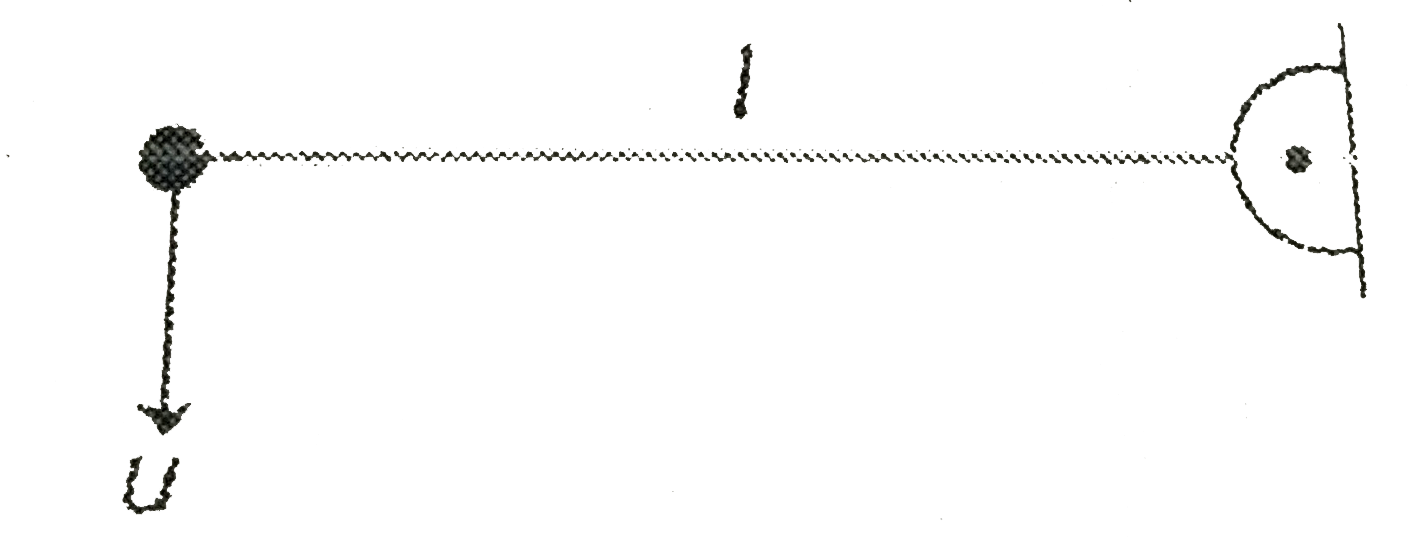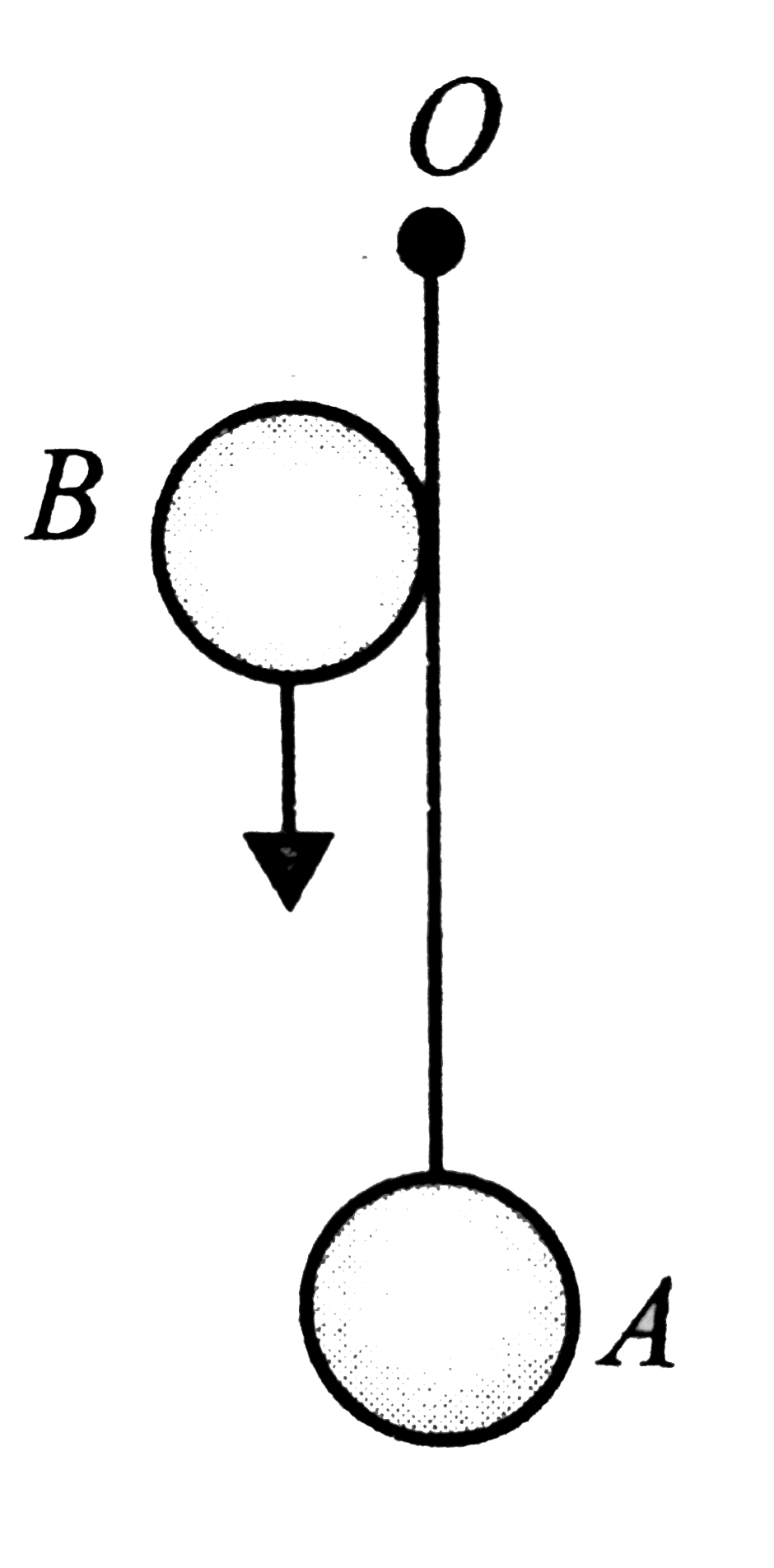A small ball of mass 2×10−3kg, having a charge 1μC, is suspended by a string of length 0.8m. Another identical ball having the same charge is kept at the point of suspension. Determine the minimum horizontal velocity that should be imparted to the lower ball so that it can make a complete revolution.
The correct Answer is:5.86
Given q=1μC=10−6C : m=2×10−3kg and l=0.8 m
Let u be the speed of the particle at its lowest point and v its speed at highest point.
At highest point three forces are acting on the particle
(a) electrostaic replusion
Fe=14πε0q2l2 (outwards)
(b) weight v = mg ( inwards)
(c) tension T (inwards)
T = 0 , if the particle has just to complete the circle and the necessary centripetal force is provided by v−Fe i .e
mv2l=w−Feor v2=lm(mg−14πε0q2l2)
v2=0.82×103⎛⎝2×103×10−9.0×109×(10−6)2(0.8)2m2/s2
or v2=2.4m2/s2
Now, the electrostatic potential energy at the lowest and highest points are equal. Hence, form conservation of mechanical energy.
Increase in gravitational potential energy decrease in kinetic energy
or mg(21)=12m(u2−v2)oru2=v2+4gl
Substituting the values of v2 from Eq.(i) we get
u2=2.4A(10)(0.8)=34.4m2/s2 ∴ u=5.86m/s
Therefore, minimum horizontal velocity imparted to the lower ball, so that it can make complete revolution, is 5.86m/s.
Topper's Solved these Questions
- BOOK - VMC MODULES ENGLISHCHAPTER - ELECTROSTATICSEXERCISE - JEE MAIN65videos
ELECTROSTATICS
- BOOK - VMC MODULES ENGLISHCHAPTER - ELECTROMAGNETIC INDUCTION & ALTERNATIVE CURRENT EXERCISE - IMPECCABLE52videos
ELECTROMAGNETIC INDUCTION & ALTERNATIVE CURRENT
- BOOK - VMC MODULES ENGLISHCHAPTER - ENERGY & MOMENTUMEXERCISE - JEE ADVANCE (ARCHIVE) - TRUE/FALSE TYPE1videos
ENERGY & MOMENTUM
Similar Questions
A ball of mass m is attached to one end of a light rod of length l, the other end of which is hinged. What minimum velocity v should be imparted to the ball downwards, so that it can complete the circle ?
 View Solution
View SolutionThe both of a pendulum has mass m = 1 kg and charge q=40μC. Length of pendulum is = 0.9 m. The point of suspensison also has the same charge 40μC. What is the minimum speed u (in m/s) should be imparted to the bob so that it can complete vertical circle ?
 View Solution
View SolutionTwo charged particles having charge 2.0×10−8C. Each are joined by an isolating string of length 1m and the system is kept on a smooth horizontal task. The tension in the string.
View SolutionA ball of mass 10−2kg and having charge +3×10−6C is tied at one end of a 1m along thread. The other end of the thread is fixed and a charge −3×10−6C is placed at this end. The ball can move in the circulr orbit of radius 1m in the vertical plane. Initially, the ball is at the bottom. Find the minimum initial horizontal velocity of the ball, so that it will be able to complete the full circle.
View SolutionThree identical small balls, each of mass 0.1 g, are suspended at one point on silk thread having a length of l=20cm . What charges should be imparted to the balls for each thread to form an angle of α=30∘ with the vertical?
View SolutionIn all the four situations depicted in Column-I, a ball of mass m is connected to a string. In each case, find the tension in the string and match the appropriate entries in Column-II.
(A)(##VMCPHYXIWORBOK01_C04E03050_Q01##)Conical pendulum(P)T=mgcosθ(B)(##VMCPHYXIWORBOK01_C04E03050_Q02##)Pendulum is swinging. Angular position is the extreme position.T is tension in extreme position(Q)Tcosθ=mg(C)(##VMCPHYXIWORBOK01_C04E03050_Q03##)The car is moving with constant acceleration.The ball is at rest with respect to car(R)Speed of ball with respect to ground is constant(D)(##VMCPHYXIWORBOK01_C04E03050_Q04##)The car is moving with constant velocity. The ball is at rest with respect to car(S)Velocity of ball with respect to ground is changing continuouslyView SolutionTwo charged particles having charge 2.0×10−8C each are joined by an insulating string of length 1 m and the system is kept on a smooth horizontal table. Find the tension in the string.
View SolutionA small steel ball A is suspended by an inextensible thread of length l=1.5m from O. Another identical ball is thrown vertically downwards such that its surface remains just in contact with thread during downward motion and collides elastically with the suspended ball. If the suspended ball just completes vertical circle after collision, calculate the velocity (in cm/s) of the falling ball just before collision (g=10ms−2).
 View Solution
View SolutionTwo small spheres, each having a mass of 20 g, are suspended form a common point by two insulating strings of length 40 cm each. The spheres are identically charged and the speration between the balls at equilibrium is found to be 4 cm . Find the charge on each sphere.
View SolutionA ball of mass 0.25 kg attached to the end of a string of length 1.96 m is moving in a horizontal circle. The string will break if the tension is more than 25 N . What is the maximum speed with which the ball can be moved
View Solution

